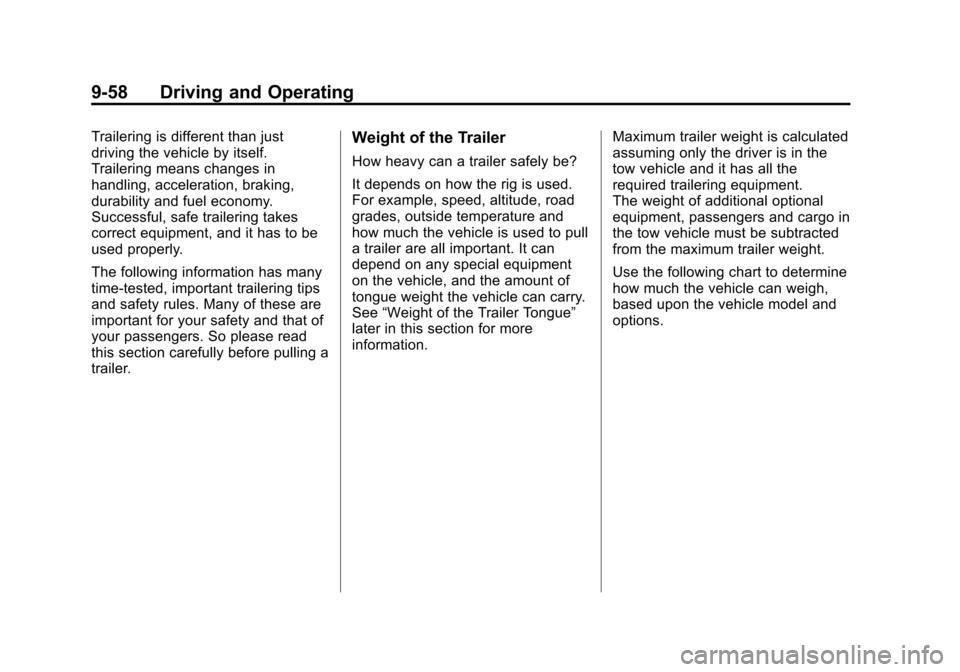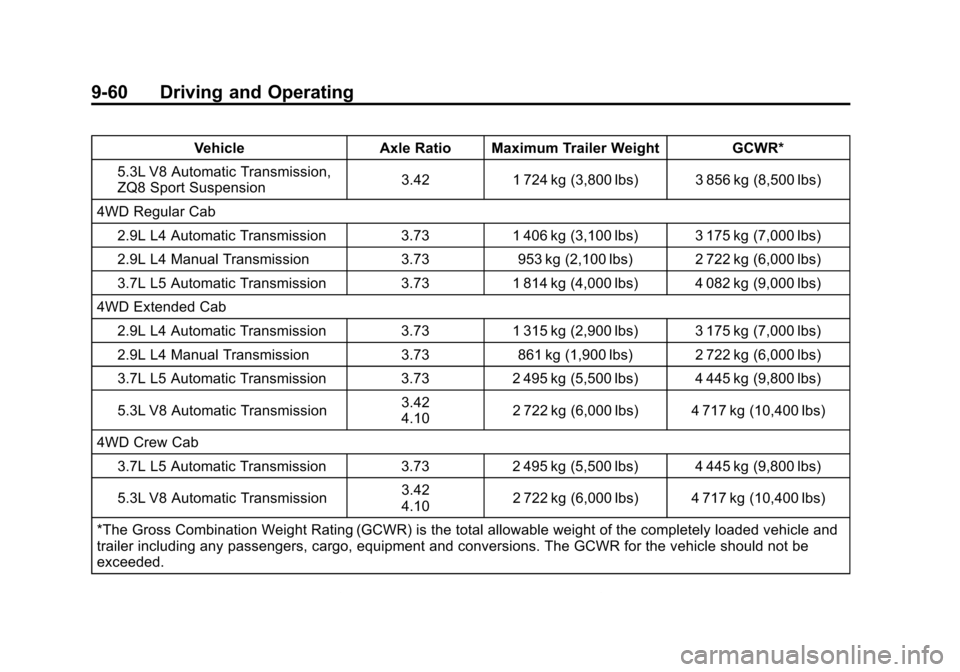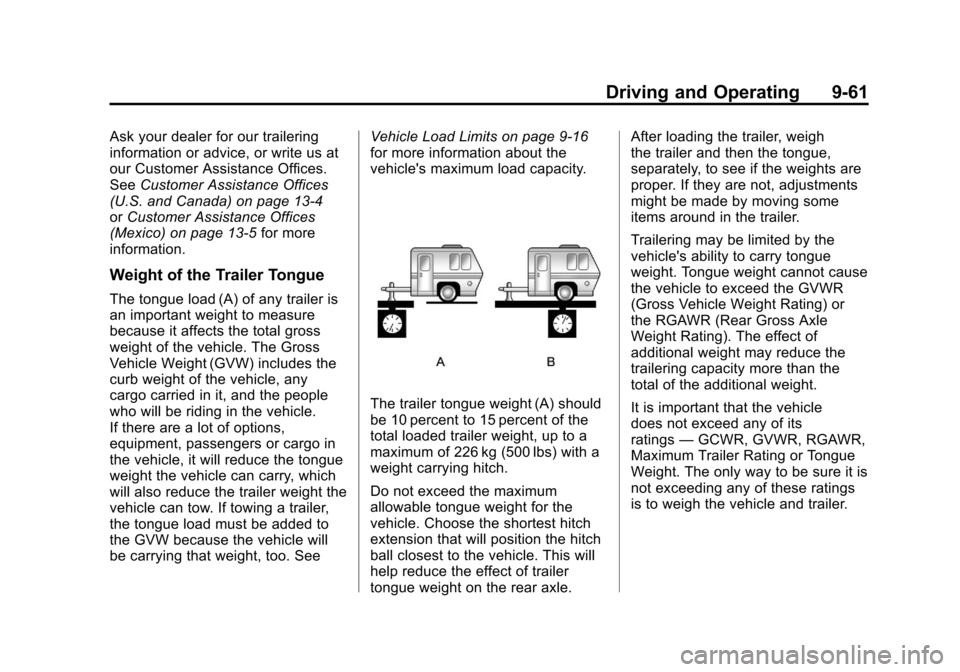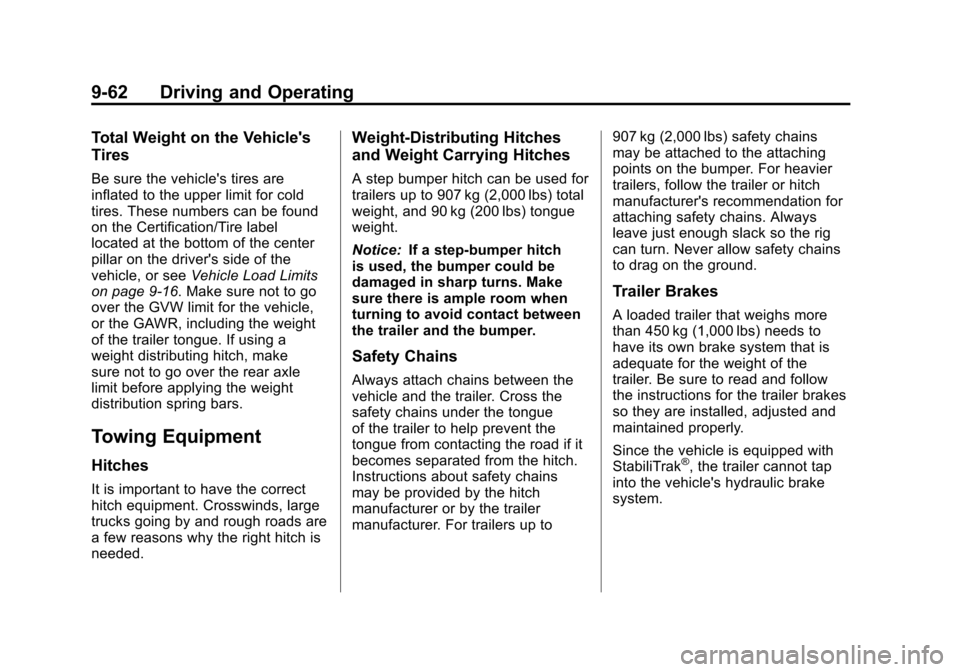2012 CHEVROLET COLORADO weight
[x] Cancel search: weightPage 232 of 394

Black plate (58,1)Chevrolet Colorado Owner Manual - 2012
9-58 Driving and Operating
Trailering is different than just
driving the vehicle by itself.
Trailering means changes in
handling, acceleration, braking,
durability and fuel economy.
Successful, safe trailering takes
correct equipment, and it has to be
used properly.
The following information has many
time-tested, important trailering tips
and safety rules. Many of these are
important for your safety and that of
your passengers. So please read
this section carefully before pulling a
trailer.Weight of the Trailer
How heavy can a trailer safely be?
It depends on how the rig is used.
For example, speed, altitude, road
grades, outside temperature and
how much the vehicle is used to pull
a trailer are all important. It can
depend on any special equipment
on the vehicle, and the amount of
tongue weight the vehicle can carry.
See“Weight of the Trailer Tongue”
later in this section for more
information. Maximum trailer weight is calculated
assuming only the driver is in the
tow vehicle and it has all the
required trailering equipment.
The weight of additional optional
equipment, passengers and cargo in
the tow vehicle must be subtracted
from the maximum trailer weight.
Use the following chart to determine
how much the vehicle can weigh,
based upon the vehicle model and
options.
Page 233 of 394

Black plate (59,1)Chevrolet Colorado Owner Manual - 2012
Driving and Operating 9-59
VehicleAxle Ratio Maximum Trailer Weight GCWR*
2WD Regular Cab 2.9L L4 Automatic Transmission 3.731 542 kg (3,400 lbs) 3 175 kg (7,000 lbs)
2.9L L4 Manual Transmission 3.731 089 kg (2,400 lbs) 2 722 kg (6,000 lbs)
3.7L L5 Automatic Transmission 3.731 814 kg (4,000 lbs) 3 856 kg (8,500 lbs)
2WD Extended Cab
2.9L L4 Automatic Transmission 3.731 452 kg (3,200 lbs) 3 175 kg (7,000 lbs)
2.9L L4 Manual Transmission 3.73998 kg (2,200 lbs) 2 722 kg (6,000 lbs)
3.7L L5 Automatic Transmission 3.732 495 kg (5,500 lbs) 4 309 kg (9,500 lbs)
5.3L V8 Automatic Transmission 3.42
3.732 722 kg (6,000 lbs) 4 717 kg (10,400 lbs)
5.3L V8 Automatic Transmission,
ZQ8 Sport Suspension 3.42
1 814 kg (4,000 lbs) 3 856 kg (8,500 lbs)
2WD Crew Cab 2.9L L4 Automatic Transmission 3.731 361 kg (3,000 lbs) 3 175 kg (7,000 lbs)
2.9L L4 Manual Transmission 3.73953 kg (2,100 lbs) 2 722 kg (6,000 lbs)
3.7L L5 Automatic Transmission 3.732 495 kg (5,500 lbs) 4 309 kg (9,500 lbs)
5.3L V8 Automatic Transmission 3.42
3.732 722 kg (6,000 lbs) 4 717 kg (10,400 lbs)
Page 234 of 394

Black plate (60,1)Chevrolet Colorado Owner Manual - 2012
9-60 Driving and Operating
VehicleAxle Ratio Maximum Trailer Weight GCWR*
5.3L V8 Automatic Transmission,
ZQ8 Sport Suspension 3.42
1 724 kg (3,800 lbs) 3 856 kg (8,500 lbs)
4WD Regular Cab 2.9L L4 Automatic Transmission 3.731 406 kg (3,100 lbs) 3 175 kg (7,000 lbs)
2.9L L4 Manual Transmission 3.73953 kg (2,100 lbs) 2 722 kg (6,000 lbs)
3.7L L5 Automatic Transmission 3.731 814 kg (4,000 lbs) 4 082 kg (9,000 lbs)
4WD Extended Cab 2.9L L4 Automatic Transmission 3.731 315 kg (2,900 lbs) 3 175 kg (7,000 lbs)
2.9L L4 Manual Transmission 3.73861 kg (1,900 lbs) 2 722 kg (6,000 lbs)
3.7L L5 Automatic Transmission 3.732 495 kg (5,500 lbs) 4 445 kg (9,800 lbs)
5.3L V8 Automatic Transmission 3.42
4.102 722 kg (6,000 lbs) 4 717 kg (10,400 lbs)
4WD Crew Cab 3.7L L5 Automatic Transmission 3.732 495 kg (5,500 lbs) 4 445 kg (9,800 lbs)
5.3L V8 Automatic Transmission 3.42
4.10
2 722 kg (6,000 lbs) 4 717 kg (10,400 lbs)
*The Gross Combination Weight Rating (GCWR) is the total allowable weight of the completely loaded vehicle and
trailer including any passengers, cargo, equipment and conversions. The GCWR for the vehicle should not be
exceeded.
Page 235 of 394

Black plate (61,1)Chevrolet Colorado Owner Manual - 2012
Driving and Operating 9-61
Ask your dealer for our trailering
information or advice, or write us at
our Customer Assistance Offices.
SeeCustomer Assistance Offices
(U.S. and Canada) on page 13‑4
or Customer Assistance Offices
(Mexico) on page 13‑5 for more
information.
Weight of the Trailer Tongue
The tongue load (A) of any trailer is
an important weight to measure
because it affects the total gross
weight of the vehicle. The Gross
Vehicle Weight (GVW) includes the
curb weight of the vehicle, any
cargo carried in it, and the people
who will be riding in the vehicle.
If there are a lot of options,
equipment, passengers or cargo in
the vehicle, it will reduce the tongue
weight the vehicle can carry, which
will also reduce the trailer weight the
vehicle can tow. If towing a trailer,
the tongue load must be added to
the GVW because the vehicle will
be carrying that weight, too. See Vehicle Load Limits on page 9‑16
for more information about the
vehicle's maximum load capacity.
The trailer tongue weight (A) should
be 10 percent to 15 percent of the
total loaded trailer weight, up to a
maximum of 226 kg (500 lbs) with a
weight carrying hitch.
Do not exceed the maximum
allowable tongue weight for the
vehicle. Choose the shortest hitch
extension that will position the hitch
ball closest to the vehicle. This will
help reduce the effect of trailer
tongue weight on the rear axle.After loading the trailer, weigh
the trailer and then the tongue,
separately, to see if the weights are
proper. If they are not, adjustments
might be made by moving some
items around in the trailer.
Trailering may be limited by the
vehicle's ability to carry tongue
weight. Tongue weight cannot cause
the vehicle to exceed the GVWR
(Gross Vehicle Weight Rating) or
the RGAWR (Rear Gross Axle
Weight Rating). The effect of
additional weight may reduce the
trailering capacity more than the
total of the additional weight.
It is important that the vehicle
does not exceed any of its
ratings
—GCWR, GVWR, RGAWR,
Maximum Trailer Rating or Tongue
Weight. The only way to be sure it is
not exceeding any of these ratings
is to weigh the vehicle and trailer.
Page 236 of 394

Black plate (62,1)Chevrolet Colorado Owner Manual - 2012
9-62 Driving and Operating
Total Weight on the Vehicle's
Tires
Be sure the vehicle's tires are
inflated to the upper limit for cold
tires. These numbers can be found
on the Certification/Tire label
located at the bottom of the center
pillar on the driver's side of the
vehicle, or seeVehicle Load Limits
on page 9‑16. Make sure not to go
over the GVW limit for the vehicle,
or the GAWR, including the weight
of the trailer tongue. If using a
weight distributing hitch, make
sure not to go over the rear axle
limit before applying the weight
distribution spring bars.
Towing Equipment
Hitches
It is important to have the correct
hitch equipment. Crosswinds, large
trucks going by and rough roads are
a few reasons why the right hitch is
needed.
Weight-Distributing Hitches
and Weight Carrying Hitches
A step bumper hitch can be used for
trailers up to 907 kg (2,000 lbs) total
weight, and 90 kg (200 lbs) tongue
weight.
Notice: If a step-bumper hitch
is used, the bumper could be
damaged in sharp turns. Make
sure there is ample room when
turning to avoid contact between
the trailer and the bumper.
Safety Chains
Always attach chains between the
vehicle and the trailer. Cross the
safety chains under the tongue
of the trailer to help prevent the
tongue from contacting the road if it
becomes separated from the hitch.
Instructions about safety chains
may be provided by the hitch
manufacturer or by the trailer
manufacturer. For trailers up to 907 kg (2,000 lbs) safety chains
may be attached to the attaching
points on the bumper. For heavier
trailers, follow the trailer or hitch
manufacturer's recommendation for
attaching safety chains. Always
leave just enough slack so the rig
can turn. Never allow safety chains
to drag on the ground.
Trailer Brakes
A loaded trailer that weighs more
than 450 kg (1,000 lbs) needs to
have its own brake system that is
adequate for the weight of the
trailer. Be sure to read and follow
the instructions for the trailer brakes
so they are installed, adjusted and
maintained properly.
Since the vehicle is equipped with
StabiliTrak
®, the trailer cannot tap
into the vehicle's hydraulic brake
system.
Page 287 of 394

Black plate (49,1)Chevrolet Colorado Owner Manual - 2012
Vehicle Care 10-49
Tire Designations
Tire Size
The following is an example
of a typical passenger vehicle
tire size.
(A) Passenger (P‐Metric) Tire:
The United States version of a
metric tire sizing system. The
letter P as the first character in
the tire size means a passenger
vehicle tire engineered to
standards set by the U.S. Tire
and Rim Association.
(B) Tire Width
:The three‐digit
number indicates the tire section
width in millimeters from
sidewall to sidewall. (C) Aspect Ratio
:A two‐digit
number that indicates the tire
height‐to‐width measurements.
For example, if the tire size
aspect ratio is 60, as shown in
item C of the illustration, it would
mean that the tire's sidewall is
60 percent as high as it is wide.
(D) Construction Code
:A
letter code is used to indicate
the type of ply construction in
the tire. The letter R means
radial ply construction; the
letter D means diagonal or
bias ply construction; and the
letter B means belted‐bias ply
construction.
(E) Rim Diameter
:Diameter of
the wheel in inches.
(F) Service Description
:These
characters represent the load
index and speed rating of the
tire. The load index represents
the load carrying capacity a tire is certified to carry. The speed
rating is the maximum speed a
tire is certified to carry a load.
Tire Terminology and
Definitions
Air Pressure:The amount
of air inside the tire pressing
outward on each square inch
of the tire. Air pressure is
expressed in kPa (kilopascal)
or psi (pounds per square inch).
Accessory Weight
:The
combined weight of optional
accessories. Some examples
of optional accessories are
automatic transmission, power
steering, power brakes, power
windows, power seats, and air
conditioning.
Aspect Ratio
:The relationship
of a tire's height to its width.
Page 288 of 394

Black plate (50,1)Chevrolet Colorado Owner Manual - 2012
10-50 Vehicle Care
Belt:A rubber coated layer of
cords that is located between
the plies and the tread. Cords
may be made from steel or other
reinforcing materials.
Bead
:The tire bead contains
steel wires wrapped by steel
cords that hold the tire onto
the rim.
Bias Ply Tire
:A pneumatic tire
in which the plies are laid at
alternate angles less than
90 degrees to the centerline of
the tread.
Cold Tire Pressure
:The
amount of air pressure in a tire,
measured in kPa (kilopascal)
or psi (pounds per square inch)
before a tire has built up heat
from driving. See Tire Pressure
on page 10‑52. Curb Weight
:The weight of a
motor vehicle with standard and
optional equipment including the
maximum capacity of fuel,
oil, and coolant, but without
passengers and cargo.
DOT Markings
:A code molded
into the sidewall of a tire
signifying that the tire is in
compliance with the U.S.
Department of Transportation
(DOT) Motor Vehicle Safety
Standards. The DOT code
includes the Tire Identification
Number (TIN), an alphanumeric
designator which can also
identify the tire manufacturer,
production plant, brand, and
date of production.
GVWR
:Gross Vehicle Weight
Rating. See Vehicle Load Limits
on page 9‑16. GAWR FRT
:Gross Axle Weight
Rating for the front axle. See
Vehicle Load Limits on
page 9‑16.
GAWR RR
:Gross Axle Weight
Rating for the rear axle. See
Vehicle Load Limits on
page 9‑16.
Intended Outboard Sidewall
:
The side of an asymmetrical tire,
that must always face outward
when mounted on a vehicle.
Kilopascal (kPa)
:The metric
unit for air pressure.
Light Truck (LT‐Metric) Tire
:A
tire used on light duty trucks and
some multipurpose passenger
vehicles.
Load Index
:An assigned
number ranging from 1 to 279
that corresponds to the load
carrying capacity of a tire.
Page 289 of 394

Black plate (51,1)Chevrolet Colorado Owner Manual - 2012
Vehicle Care 10-51
Maximum Inflation Pressure:
The maximum air pressure to
which a cold tire can be inflated.
The maximum air pressure is
molded onto the sidewall.
Maximum Load Rating
:The
load rating for a tire at the
maximum permissible inflation
pressure for that tire.
Maximum Loaded Vehicle
Weight
:The sum of curb
weight, accessory weight,
vehicle capacity weight, and
production options weight.
Normal Occupant Weight
:The
number of occupants a vehicle
is designed to seat multiplied by
68 kg (150 lbs). See Vehicle
Load Limits on page 9‑16.
Occupant Distribution
:
Designated seating positions. Outward Facing Sidewall
:The
side of an asymmetrical tire that
has a particular side that faces
outward when mounted on a
vehicle. The side of the tire that
contains a whitewall, bears
white lettering, or bears
manufacturer, brand, and/or
model name molding that is
higher or deeper than the same
moldings on the other sidewall
of the tire.
Passenger (P-Metric) Tire
:A
tire used on passenger cars
and some light duty trucks and
multipurpose vehicles.
Recommended Inflation
Pressure
:Vehicle
manufacturer's recommended
tire inflation pressure as shown
on the tire placard. See Tire
Pressure on page 10‑52
andVehicle Load Limits on
page 9‑16. Radial Ply Tire
:A pneumatic
tire in which the ply cords that
extend to the beads are laid at
90 degrees to the centerline of
the tread.
Rim
:A metal support for a tire
and upon which the tire beads
are seated.
Sidewall
:The portion of a tire
between the tread and the bead.
Speed Rating
:An
alphanumeric code assigned to
a tire indicating the maximum
speed at which a tire can
operate.
Traction
:The friction between
the tire and the road surface.
The amount of grip provided.
Tread
:The portion of a tire
that comes into contact with
the road.